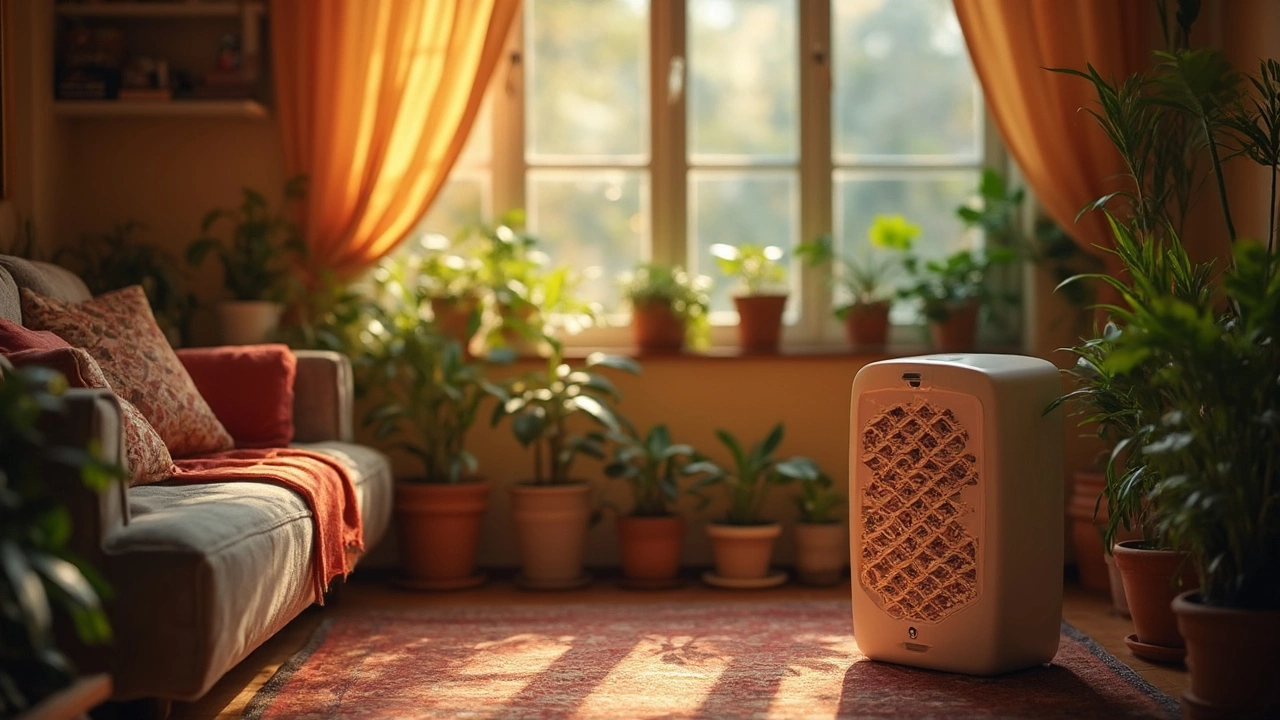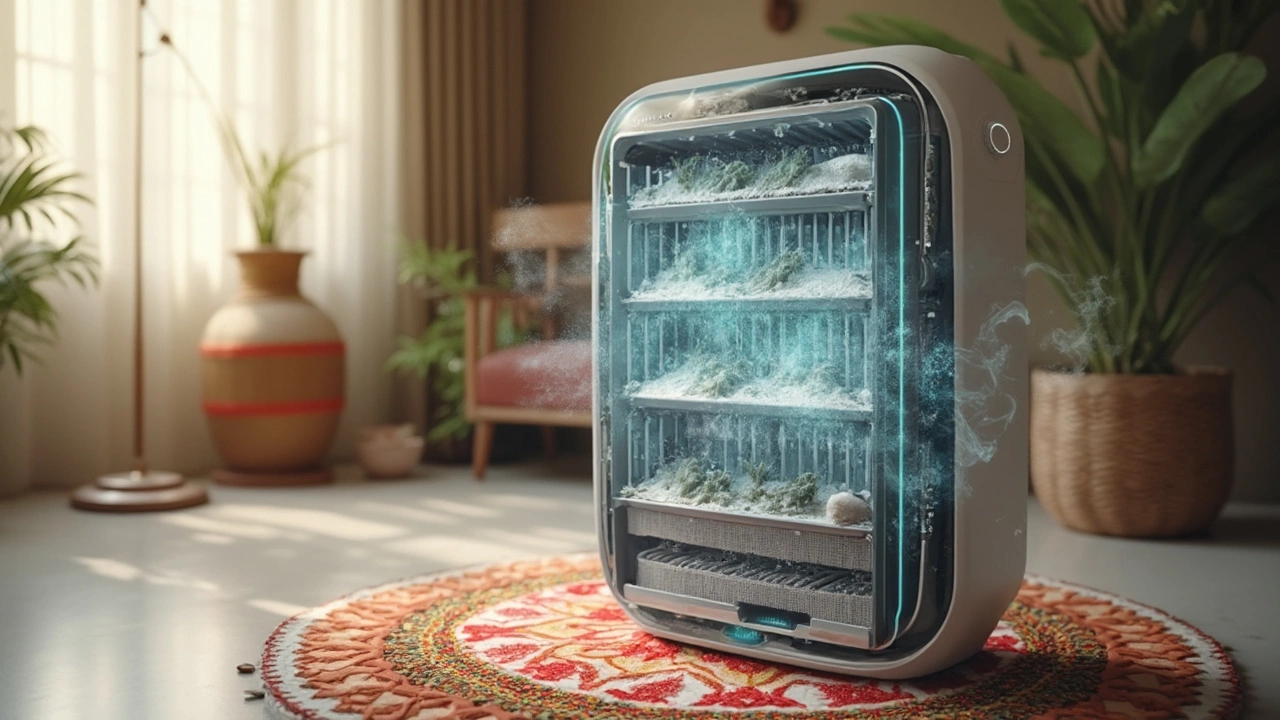
So, you've got an air purifier and you're wondering, 'Should this thing be running all the time?' You're not alone. The decision to keep it on 24/7 isn't as straightforward as it seems. Let's break it down.
First off, air purifiers are champs at clearing out dust, pollen, smoke, and even some nasty odors from the air. If you or anyone in your home suffers from allergies or asthma, running the purifier continuously can feel like a game-changer.
But, does keeping it on all the time make a huge difference? Well, it depends. Factors like room size, pollution levels, and how often your windows are open can all play a role. Plus, running it non-stop uses more electricity, so there's the energy cost to consider.
Luckily, there are ways to make sure you're getting the most bang for your buck with your air purifier without necessarily keeping it on all day. Stay tuned as we dive deeper into how these devices work, and share some tips on maintaining top-notch air quality in your home without breaking the bank.
- How Air Purifiers Work
- Benefits of Continuous Operation
- Energy Use and Efficiency
- Maximizing Your Air Purifier's Performance
How Air Purifiers Work
Ever wondered what magic happens inside those trusty air purifiers? While it might seem like they just suck in air and blow it back out, there's a bit more going on. Let’s break it down so it makes sense.
Filtering Mechanisms
Most air purifiers use some type of filter system to clean the air. The most common are HEPA filters, known for capturing particles as small as 0.3 microns. That includes dust mites, pollen, and even some bacteria.
Then there are activated carbon filters. These bad boys are especially good at tackling odors and volatile organic compounds (VOCs) like those released from paints and new furniture. Together, these filters can look like Batman and Robin in your air-cleaning lineup.
Electrical Attraction
Some purifiers use an ionization process, releasing charged ions that latch onto airborne particles, causing them to clump together and fall out of the air—or get caught by the device’s filter. This can be especially handy for dealing with smoke particles.
UV Light Technology
Another cool trick is UV light. Some purifiers come equipped with ultraviolet lamps to zap and destroy germs and bacteria. It’s like installing a tiny germ-killing sun in your room.
Performance Metrics
Though every purifier may boast varying features, the key metric to watch for is the Clean Air Delivery Rate (CADR). This measures how rapidly the purifier can clean smoke, dust, and pollen. Higher CADR, faster cleaning.
Take note that air purifiers aren’t miracle workers, though. They can't remove gases like radon, and they won’t trap allergens hiding in your pillows. And while they’re effective allies in improving air quality, keeping them maintained with regular filter changes is crucial. This ensures they’re in tip-top shape to fight off unwanted air invaders.
Benefits of Continuous Operation
Running your air purifiers non-stop might sound excessive, but there are some solid upsides to it. Let’s delve into what you could gain from letting the device chug along continuously.
Consistent Air Quality
The number one benefit is consistent air quality. When purifiers are working round-the-clock, they keep tackling airborne pollutants as they appear, leading to fresher, cleaner air at all times. If you're in an area with high pollution or allergens, this means a consistent defense against sneezing fits or itchy eyes.
Effective Allergen Control
If anyone in your household struggles with allergies, you're probably familiar with how sneaky allergens can be. They're not just a daytime problem. Dust mites and other nasties love to lurk in your home. Keeping your air purifier on all the time helps minimize these allergens' presence, making life a lot more comfortable for allergy sufferers.
Odor Elimination
No one wants their home to smell like last night's dinner or their pet’s favorite hangout spot. By running an air purifier continuously, you can stay ahead of lingering odors. It’s especially useful in small spaces where smells tend to linger longer.
Real-Time Response to Pollution Spikes
Pollution levels aren't static; they fluctuate throughout the day. With a continuous operation, your purifier is ready to handle sudden increases in pollutants, like those from cooking or opening windows on a breezy day.
Low Maintenance and Worry-Free Operation
Some modern air purifiers come with smart features that automatically adjust settings based on air quality levels. This means you don't have to fret about turning the device on or off, offering a carefree experience while still benefiting from cleaner air.
| Type of Pollutant | Reduction Percentage |
|---|---|
| Dust and Pollen | Up to 90% |
| Smoke and Odors | Up to 80% |
| Mold Spores | Up to 85% |
These perks make a convincing case for letting your air purifiers do their magic all the time, especially in homes with specific needs. Just remember to balance against energy costs and personal preferences!

Energy Use and Efficiency
When it comes to air purifiers, one of the big questions is their energy consumption. Running an air purifier constantly can impact your electricity bill, so it's worth knowing what you're getting into.
Most air purifiers operate at around 30 watts for small units to over 100 watts for larger ones. Compared to other home appliances, they're not huge energy hogs, but costs can add up if left running 24/7.
Estimating Energy Costs
Let's break it down with some simple math. If your purifier is 50 watts and you run it all the time, that's 1.2 kilowatt-hours (kWh) a day. Depending on your local electricity rates, running it non-stop might cost you $3 to $5 a month. Keep in mind, compared to the potential health benefits, some may find this a worthwhile investment.
Tips for Efficiency
- Use air purifiers in rooms where you spend the most time. You don't have to purify the entire house if you mainly hang out in just a few rooms.
- Consider units with 'eco-mode' or automatic shut-off features when air quality improves, helping reduce unnecessary energy use.
- Ensure your purifier is the right size for the room. A unit too small for the space won't be as efficient, leading to longer run times.
Sometimes, it's necessary to keep your purifier on overnight, especially if you're using it in a bedroom to combat allergens. Use settings that offer good air quality without overdoing it, such as medium speed instead of max power.
| Air Purifier Size | Typical Watts | Estimated Monthly Cost |
|---|---|---|
| Small | 30 watts | $2 - $4 |
| Medium | 50 watts | $3 - $5 |
| Large | 100 watts | $5 - $8 |
Overall, balancing energy use with the benefits of cleaner air is key. Focus on optimizing your air purifier settings rather than worrying about it burning a hole in your pocket.
Maximizing Your Air Purifier's Performance
Getting the most out of your air purifier isn't rocket science, but a little know-how goes a long way. With a few smart moves, you can boost its effectiveness and keep your home's air quality top-notch.
1. Right Placement Matters
Position your air purifier in the right spot. Ideally, place it in areas with high foot traffic or where allergens accumulate, like living rooms or bedrooms. Ensure it's not blocked by furniture or walls, which can mess with airflow.
2. Filter Maintenance is Key
Regularly check and replace filters according to the manufacturer's instructions. A clogged filter makes your purifier work harder and cuts down on performance. Mark it in your calendar if you need a reminder.
3. Make Use of Settings
Most air purifiers come with various settings. Use the higher settings when dust or pollen levels are up, or when you're vacuuming—which can stir up particles. At night or when you're out, switch to a lower setting to conserve energy.
4. Keep Windows and Doors Closed
It might seem obvious, but if you're running your air purifier, try to keep windows and doors closed to stop new pollutants from entering.
5. Know When to Run It
Running your purifier all the time isn’t always necessary. Consider air quality monitors to check current conditions. If the air quality's good, you can safely turn it off for a bit.
Bonus Tip: Calculate the Right Size
Ensure your purifier is sized right for your space. Use the Clean Air Delivery Rate (CADR) to guide your choice. A purifier that's too small for a big room won't be very effective.
| CADR Rating | Recommended Room Size |
|---|---|
| 100-200 | Small (up to 150 sq ft) |
| 200-300 | Medium (150-300 sq ft) |
| 300+ | Large (300+ sq ft) |
By following these steps, you'll ensure your air purifiers are running as efficiently as possible, keeping your home's air quality in check without unnecessary stress on the device.